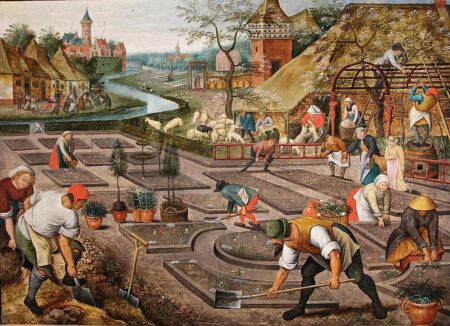- It’s pretty rare to have a mainstream media piece on the use of crop wild relatives for climate change adaptation but here we have an example with tomato, so make the most of it. There’s an interesting wrinkle though, so more to come, time permitting.
- It’s even rarer to see a mainstream media piece on genebank staff getting trained. What’s going on out there?
- Not exactly mainstream media, but how many times have you seen an official government press release on its livestock censuses? Anyway, India’s last one was carried out in 2019 and covered 184 breeds of 16 species. Wonder where the data is.
- Speaking of government press releases, here’s one from USDA announcing that it has joined a coffee breeding network. Well, I for one think it’s important.
- And staying in the USA, you know how you read in mainstream textbooks that Native Americans got horses from retreating Spanish colonists after the Pueblo Revolt? And you know how Native Americans have been saying that’s not what they think happened? How rare is it that a scientific paper involving Indigenous authors overturns a mainstream historical narrative and is splashed all over the mainstream media? Very rare, that’s how rare.
Nibbles: Food tree, Wild chocolate, Cacao, Cassava in Africa, Indigenous ABS, Abbasid food, Valuing trees
- Gastropod episode on The Fruit that Could Save the World. Any guesses what that might be?
- Atlas Obscura podcast on an apparently now famous wild-harvested chocolate from Bolivia. But how wild is it really?
- BBC podcast on cacao for balance.
- Forbes touts an African cassava revolution. What, no podcast?
- Very interesting piece from the ever reliable Modern Farmer on how a small seed company called Fedco Seeds designated a bunch of maize landraces as “indigenously stewarded,” and are paying 10% of what they make from the sale of their seeds to a pooled Indigenous fund which goes to support a local, multi-tribal project called Nibezun. A sort of mini-MLS? Definitely worth a podcast. Any takers?
- A long but rewarding article in New Lines Magazine describes medieval cookbooks from the Abbasid caliphate. The recipes make up for the somewhat stilted podcast.
- BGCI publication on how the Morton Arboretum works out whether it should be growing a particular population or species of tree. The trick is to quantify 5 types of “value”: environmental, evolutionary, genetic diversity, horticultural, conservation. Though one could also consider hostorical/cultural, educational and economic value as well. I suspect in the end it comes down to whether it looks nice in an available gap. If I were to do a podcast on this, I’d test it out with the tree in the first of these Nibbles.
Brainfood: Human diversity, Wild rye, Caribbean cassava, Three Sisters, Old beer, Old apples, Feral crops, Crop resynthesis
- Palaeogenomics of Upper Palaeolithic to Neolithic European hunter-gatherers. Farmers may have pushed hunter-gatherers to the northern edge of Europe while also in mixing with them.
- Identification and exploitation of wild rye (Secale spp.) during the early Neolithic in the Middle Euphrates valley. Those Europeans on the move — both farmers and hunter-gatherers — would have been familiar with wild rye, but that’s pretty much gone from the Fertile Crescent now.
- Caribbean Deep-Time Culinary Worlds Revealed by Ancient Food Starches: Beyond the Dominant Narratives. But enough about Europe. It wasn’t always all about cassava in the pre-colonial, and indeed colonial, Caribbean…
- Reuniting the Three Sisters: collaborative science with Native growers to improve soil and community health. …as there was also the maize/beans/squash system in that part of the world, and may well be again.
- Understanding Early Modern Beer: An Interdisciplinary Case-Study. Something else that could come back is early modern Irish beer, and I’d be there for that.
- Forgotten forest relics: Apple trees (Malus spp.) in eastern U.S. forests. Old abandoned orchards, and escapes therefrom, could have lots of interesting apple diversity. Early modern American cider, anyone?
- Building a feral future: Open questions in crop ferality. And it’s not just apples. It’s a whole movement in fact.
- Resynthesized Rapeseed (Brassica napus): Breeding and Genomics. Sure, we can rebuild it, we have the technology. But will it go feral on us again?
Nibbles: Food system transformation, Global food crisis, Rewilding, Genomics, Data management
- According to WWF, Solving the Great Food Puzzle involves, inter alia, nutritious indigenous crops, agrobiodiverse cropping systems, and traditional food cultures. Those are just 3 of 20 levers for food system transformation. Is it me or are levers and accelerators the current flavours of the month?
- Even the Gates Foundation agrees on that indigenous crop thing, kinda sorta, if you squint. In this piece, for example, Enock Chikava, Interim Director, Agricultural Development, waxes lyrical about teff.
- Meanwhile, in the middle of its tomato shortage, and not much interested in teff, the UK is betting on re-establishing prehistoric landscapes full of wild pigs and bison. Bold move.
- But who needs bison protein when you have the genome of the faba bean? Which after all is a nutritious indigenous crop, part of agrobiodiverse cropping systems, and a component of traditional food cultures.
- Ah, but you need to manage all that data on indigenous crops, and Clemson University is there to help. WWF take note.
Spring forward!
Pieter Breughel the Younger, CC BY-SA 4.0, via Wikimedia Commons
